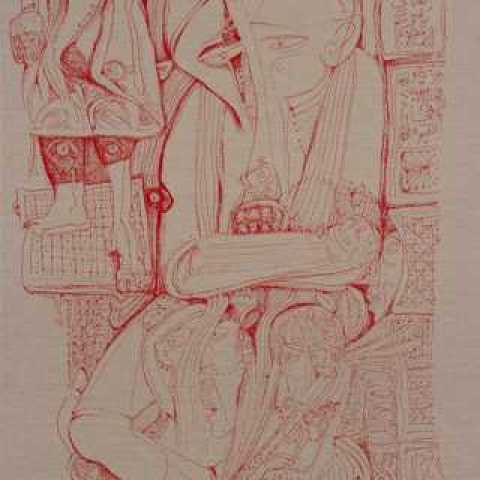Saatchi Gallery
King's Road
London
SW3 4SQ
United Kingdom

When Ibrahim El-Salahi is drawing he gets lost in his work and has temporary respite from his chronic back problems. At 88 the 'Godfather of African Modernism' says it is the only time he has let up from the pain.
For the last two years he has created an extraordinary body of work from the comfort of an armchair, refusing to let physical restriction limit his ambition. He makes around 180 miniature drawings in pen and ink on the back of medicine packets and envelopes after consuming their contents.
These are drawings in their own right but they are also seeds for a very ambitious project. He wants to make larger scale work within his constraints and achieves this by using the drawings as a source or nucleus from which to create large unique mono-print paintings transferred by screen. The image is impressed onto strong woven linen canvas many times over until a thick inky texture is achieved, amplifying the character of the marks. Limited by his physical constraint this method allows him to do something that otherwise would have not been possible.
This approach of playing with scale and ways of engaging the viewer is not without precedent. Throughout his career he has returned to the nucleus versus the whole and the organic opening up of an image.
When he was in prison in the 1970s he drew on small scraps of cement casings, which he would join together whilst the guards were not watching to create a whole. Thereafter all his black and white works were expansive in nature, such as starting with the nucleus and adding pieces of paper, letting the work grow organically, or in series within notebooks.
As far back as the 1950s Ibrahim was contemplating how to engage people's attention, hence his first forays into what became known as the School of Khartoum. Disappointed by the lack of attention from his fellow countrymen and women when he showed his Slade work at the Grand Hotel in Khartoum in the late 1950s, he noted that by writing in Arabic calligraphy on the drawings it attracted interest and people paused to read. From there the words and letters slowly evolved as he explored the pictorial qualities and hidden shapes within calligraphic forms. It was a practical means to an end, a way into the work and a communication. The pain relief imagery now also includes a nod to these early works, as he makes use of the pictorial possibilities of braille on the medicine packets.
This body of work made despite and because of circumstance allows the viewer to delve into the mind of the artist and experience his memories of a long and fruitful life. Since completion of this project the artist has been inspired re-entering his new studio for the first time in over two years.
Biography
Born in Sudan in 1930, Ibrahim El-Salahi is one of the most important living African artists and a key figure in the development of African Modernism. El-Salahi grew up in Omdurman, Sudan and studied at the Slade School in London. On his return to Sudan in 1957, he established a new visual vocabulary, which arose from his own pioneering integration of Sudanese, Islamic, African, Arab and Western artistic traditions. In 2013 Ibrahim El-Salahi became the first African artist to be given a full retrospective at Tate Modern. His work is included in the permanent collections of the Museum of Modern Art, New York; The Metropolitan Museum of Art, New York; The Art Institute of Chicago; The Smithsonian Institute, Washington DC; The British Museum, London; Tate Modern, London; The Guggenheim Museum, Abu Dhabi; The Ashmoleum Museum, Oxford, Sharjah Art Foundation, UAE; The National Gallery, Berlin, and many others.
